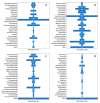Influence of Human Activities on Broad-Scale Estuarine-Marine Habitats Using Omics-Based Approaches Applied to Marine Sediments
- PMID: 31590307
- PMCID: PMC6843362
- DOI: 10.3390/microorganisms7100419
Influence of Human Activities on Broad-Scale Estuarine-Marine Habitats Using Omics-Based Approaches Applied to Marine Sediments
Abstract
Rapid urban expansion and increased human activities have led to the progressive deterioration of many marine ecosystems. The diverse microbial communities that inhabit these ecosystems are believed to influence large-scale geochemical processes and, as such, analyzing their composition and functional metabolism can be a means to assessing an ecosystem's resilience to physical and chemical perturbations, or at the very least provide baseline information and insight into future research needs. Here we show the utilization of organic and inorganic contaminant screening coupled with metabolomics and bacterial 16S rRNA gene sequencing to assess the microbial community structure of marine sediments and their functional metabolic output. The sediments collected from Moreton Bay (Queensland, Australia) contained low levels of organic and inorganic contaminants, typically below guideline levels. The sequencing dataset suggest that sulfur and nitrite reduction, dehalogenation, ammonia oxidation, and xylan degradation were the major metabolic functions. The community metabolites suggest a level of functional homogeneity down the 40-cm core depth sampled, with sediment habitat identified as a significant driver for metabolic differences. The communities present in river and sandy channel samples were found to be the most active, with the river habitats likely to be dominated by photoheterotrophs that utilized carbohydrates, fatty acids and alcohols as well as reduce nitrates to release atmospheric nitrogen and oxidize sulfur. Bioturbated mud habitats showed overlapping faunal activity between riverine and sandy ecosystems. Nitrogen-fixing bacteria and lignin-degrading bacteria were most abundant in the sandy channel and bioturbated mud, respectively. The use of omics-based approaches provide greater insight into the functional metabolism of these impacted habitats, extending beyond discrete monitoring to encompassing whole community profiling that represents true phenotypical outputs. Ongoing omics-based monitoring that focuses on more targeted pathway analyses is recommended in order to quantify the flux changes within these systems and establish variations from these baseline measurements.
Keywords: 16S rRNA gene sequencing; chemometrics; community metabolomics; marine ecosystems; natural environment.; sediments.
Conflict of interest statement
The authors declare no conflict of interest.
Figures





References
-
- Australian Bureau of Statistics . Year Book Australia. Australian Bureau of Statistics; Canberra, Australia: 2004.
-
- Lyons M.B., Phinn S.R., Roelfsema C.M. Long term land cover and seagrass mapping using Landsat and object-based image analysis from 1972 to 2010 in the coastal environment of South East Queensland, Australia. ISPRS J. Photogramm. Remote. Sens. 2012;71:34–46. doi: 10.1016/j.isprsjprs.2012.05.002. - DOI
-
- Liu C.M., Fu H.S., Cao J.B., Xu Y., Yu Y.Q., Kronberg E.A., Daly P.W. Rapid pitch angle evolution of suprathermal electrons behind dipolarization fronts. Geophys. Res. Lett. 2017;44:110–116. doi: 10.1002/2017GL075007. - DOI
-
- Savage C., Leavitt P.R., Elmgren R. Effects of land use, urbanization, and climate variability on coastal eutrophication in the Baltic Sea. Limnol. Oceanogr. 2010;55:1033–1046. doi: 10.4319/lo.2010.55.3.1033. - DOI
LinkOut - more resources
Full Text Sources

